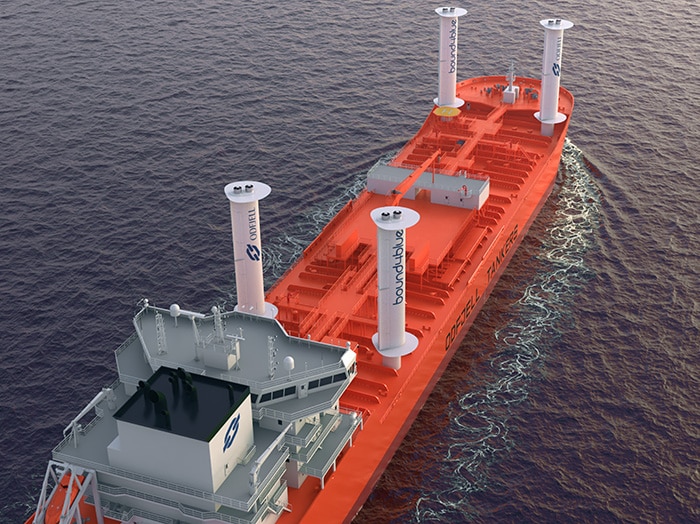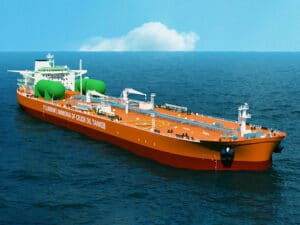
Shipping turns to wind and bubbles to cut carbon
Written by Nick Blenkey
Bound4blue suction sails will make their tanker debut on an Odfell chemical tanker. (Credit: Odfjell)
Helped along by major charterers, including Cargill and Brazilian ore giant, Vale, more ships are being ordered or retrofitted with wind assisted propulsion and hull air lubrication systems. Those options have been on the table for years and are proven fuel, and thus carbon savers. What’s not quite so quantifiable is how much fuel they save. The weasel words “up to” appear in most claims for them. Still, pressures from cargo shippers to wring Scope 3 GHG emissions from their overall carbon footprints are, in turn, pressing shipping to take any carbon savings it can get, however incremental.
Very visible evidence of this trend is Pyxis Ocean, a 2017-built 80,962 dwt bulker chartered by Cargill that become the first ship to be fitted with BAR Technologies’ WindWings. The vessel, owned by Mitsubishi Corporation subsidiary MC Shipping, was retrofitted with the two hard sails at a COSCO shipyard in China and, as this was written, was enroute to Brazil.
“The maritime industry is on a journey to decarbonize—it’s not an easy one, but it is an exciting one,” said Jan Dieleman, president of Cargill’s Ocean transportation business. “At Cargill we have a responsibility to pioneer decarbonizing solutions across all our supply chains to meet our customer’s needs and the needs of the planet. A technology like WindWings doesn’t come without risk, and as an industry leader—in partnership with visionary shipowner MC Shipping—we are not afraid to invest, take those risks and be transparent with our learnings to help our partners in maritime transition to a more sustainable future.”
Manufactured by BAR Technologies industrialization partner Yara Marine Technologies, WindWings are large wing sails measuring up to 45 meters in height that can be fitted to the deck of bulk cargo ships to wind assisted propulsion. According to BAR Technologies, they are expected to generate average fuel savings of up to 30% on newbuild vessels.
The WindWings project is co-funded by the European Union as part of the CHEK Horizon 2020 initiative and can help the industry meet GHG reductions targets by offering a retrofit solution that is capable of decarbonizing existing vessels, which is particularly relevant given that 55% of the world’s bulker fleet is up to nine years in age.
The performance of the Pyxis Ocean sails will be closely monitored over the coming months to further improve their design, operation, and performance, with the aim of using the Pyxis Ocean installation to inform the scale-up and widespread adoption of the technology. BAR Technologies is already planning to build hundreds of wings over the next four years and is also researching newbuilds with differing hydrodynamic forms.
Perhaps the best known new-generation wind assisted propulsion systems (WAPS) out there are the rotor sails pioneered by Finland’s Norsepower Oy. Now a 325,000 dwt very large ore carrier (VLOC) newbuilding under construction in China for charter to Brazilian mining giant Vale has been fitted with five Norsepower tilting rotor sails. Tilting the rotor sails, using hydraulic cylinders, will enable efficient cargo operations.
The vessel is owned by Pan Ocean Ship Management. Norsepower has analyzed the routes for the vessel on its charter to Vale and estimates that the rotor sail technology would be able to achieve an efficiency gain of up to 8% and a consequent reduction of up to 3,400 tons of CO2 per year.
To enable efficient cargo operations, the five 24-meter high and 4-meter diameter rotor sails can be tilted by using hydraulic cylinders.
“We are committed to supporting the adoption of clean technology solutions for shipping to ensure that Vale’s sustainability objectives are achieved,” said Rodrigo Bermelho, shipping technical manager at Vale. “Installing five rotor sails will maximize our fuel and emissions savings. We are working with Norsepower to ensure this newbuild is as environmentally friendly as possible and can achieve significant reductions in fuel consumption and CO2 emissions. If the pilot proves effective, it is estimated that at least 40% of the fleet will be able to use the technology, which would result in a reduction of almost 1.5% of Vale’s annual iron ore maritime transport emissions.”
Another wind assisted propulsion solution that has been getting a lot of attention is the bound4blue eSAIL suction sail system, which is set to soon make its tanker sector debut on an Odfjell chemical tanker.
“Since 2020, we have been studying sail technologies as a potential energy efficiency measure for our fleet, and we are excited to now take the next step by partnering with bound4blue to implement their pioneering eSAILsystem on one of our chemical tankers,” said Jan Opedal, manager projects at Odfjell. “This technology has significant potential to reduce emissions by harvesting the energy on the ship itself and transforming it directly into a forward thrust.”
Bound4blue says that the eSAIL technology is based on active boundary layer control using suction.
“When exposed to wind, with the suction off, it only produces drag as with any other non-lifting structure,” says bound4blue. “However, when the suction is activated, a small amount of air is sucked in, which re-adheres the airflow to the sail, generating enormous amounts of lift with low drag.”
Odfjell says its decision to cooperate with bound4blue was supported by an extensive study conducted by Swedish research institute SSPA, evaluating various Wind Assisted Propulsion Systems for the Odfjell fleet. The pioneer installation will be completed in 2024.
“This project marks another leap in our dedication to decarbonization,” says Erik Hjortland, VP technology at Odfjell. “As the first tanker company to test the suction-sail technology, we demonstrate our innovative capabilities and dedication to a more sustainable shipping sector. We all have a responsibility to use as few resources as possible, and Odfjell’s long-time efforts in energy efficiency have significantly reduced our fleet’s emissions. The work continues, and we look forward to documenting further improvements with the installation of suction sails.”
Another carbon reduction solution soon to be retrofitted on an Odfjell vessel is Alfa Laval’s OceanGlide hull air lubrication system on one of its vessels later this year. OceanGlide differs from other hull air lubrication solutions in that it uses the patented fluidic technology developed by Rotterdam-based Marine Performance Systems B.V., which Alfa Laval acquired earlier this year after earlier taking a minority stake in the company.
The patented and class-approved system utilizes fluidic oscillators to generate an even layer of micro air bubbles across a vessel’s entire flat bottom, reducing friction and drag. An advantage claimed for the technology is the ability to regulate power consumption through oscillation bands. OceanGlide uses its fluidic technology to create streamlined sections on the vessel’s flat bottom, each with its own fluidic band that generates bubbles.
The independent steering of each band allows a more controlled and streamlined flow of air bubbles to deliver optimal efficiency, maximum coverage, and reduced compressor power, meaning fewer compressors are needed. The system requires no structural modifications or vessel recertification, which makes it well suited for retrofitting as well as for newbuilds. The fluidic bands, designed with a low profile and no moving parts, can be easily configured underneath the ship at any shipyard, says Alfa Laval.
“Odfjell has installed more than 130 energy-saving devices on its vessels since 2014. In first quarter 2023 we reported a historical low carbon intensity—more than 50% below the IMO baseline for our fleet,” says Odfjell’s Hjortland. “Our decarbonization efforts do not stop with this achievement—now the time has come to start deploying more enhanced technologies. We believe fluidic air lubrication technology is a natural next step for us, and we look forward to deploying the OceanGlide system to further reduce our carbon intensity.”
Meantime, at the beginning of this year, hull air lubrication pioneer Silverstream Technologies signed an agreement with CSSC Jiangnan Shipyard Group to supply its Silverstream System, on a series of newbuild 175,000 cubic meter LNG carriers on order for Abu Dhabi National Oil Company (ADNOC) Logistics & Services. The first six ships in the series are expected to be delivered in 2025 and 2026.
While the technology is suited to almost all segments in shipping, Silverstream says that LNG carriers are particularly strong candidates for the Silverstream System because of their hull form and large flat bottom.
“Partnering with ADNOC Logistics & Services to install our Silverstream System on these vessels will help to create a new benchmark for LNGC efficiency and reinforces the maturity of our technology as a verified fuel and emissions reduction solution,” said Silverstream founder and CEO Noah Silberschmidt.
Underscoring the Silverstream System’s attractions in the LNG carrier (LNGC) sector, the ADNOC order was rapidly followed by an order that will see the solution fitted on four 175,000-cubic-meter LNG carriers (plus two options) being built at Dalian Shipbuilding Industry Company (DSIC) for China Merchants Energy Shipping—the first Chinese-owned, Chinese-built LNG carriers to join the global fleet.
The installations will take place over the next two years, with work expected to be completed by the end of 2024, in line with DSIC’s building schedule.
The order further underpins Silverstream’s strong track record in the large LNGC segment, bringing the company’s total number of contracted LNGCs to 23 vessels, eight of which are already in-service. It also follows another recent deal with Abu Dhabi National Oil Company to install the Silverstream System on six of the first LNGCs built at China’s Jiangnan shipyard.




